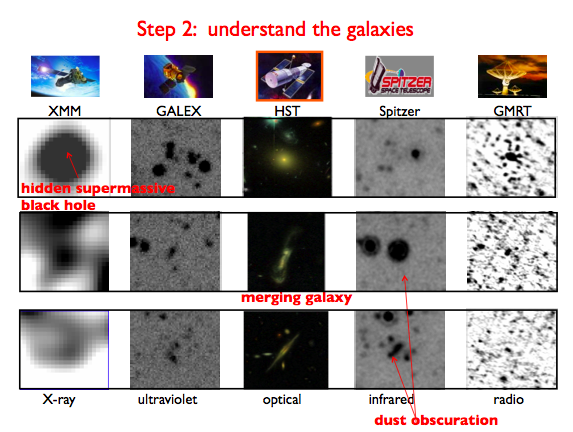Public pages > STAGES telescopes
Seeing the whole picture
STAGES has observed the Abell 901/902 supercluster with many of the world's most powerful telescopes, covering wavelengths from the X-ray all the way to the radio.What do we gain by looking at the same objects in many different ways? The figure below shows just how different galaxies can look when we use telescopes that are sensitive to different types of radiation.
For example, star formation hidden behind a shroud of dust can be invisible to Hubble but easily apparent to the Spitzer Space Telescope. Likewise, an otherwise dull-looking blob of a galaxy may be resolved into a spectacular merger with the resolution of Hubble. A supermassive black hole lurking at the centre of a galaxy can be so highly obscurbed that only the most energetic X-ray photos can get through.

Clearly, to see the whole picture and build up a complete census of galaxy properties, we need to observe our galaxies at as many wavelengths as possible.
STAGES multiwavelength coverage
Below we list the facilities used for STAGES, and what we are looking for at each wavelength.| Instrument/Survey | scientific
contribution |
|
 |
Hubble
Space Telescope: high resolution images at visible wavelengths |
galaxy morphologies, sizes, and weak gravitational lensing |
 |
COMBO-17:
ground-based optical images in 17 different filters |
photometric
redshifts, stellar masses, and galaxy spectral energy distributions
(SEDs) for 15000 galaxies |
 |
2dF
spectrograph: spectra for 300 cluster galaxies |
accurate
spectroscopic redshifts; star formation properties |
 |
XMM-Newton:
X-ray imaging and spectra |
mapping
of hot intracluster medium; identification of active
galactic nuclei |
 |
Spitzer
Space Telescope: mid-infrared imaging |
identification
of dust-obscured star formation and active galactic nuclei |
 |
COMBO-17+4: near-infrared extention to COMBO-17 |
improved
photometric redshifts and stellar mass estimation |
 |
GALEX: near- and far-ultraviolet imaging |
identification
of active star formation |
 |
GMRT: radio imaging |
identification
of dust-obscured star formation, radio galaxies |
 |
computer
modelling: constrained simulations |
models of the dark matter, gas and galaxies help us to understand how the system may have formed |



